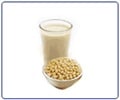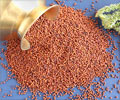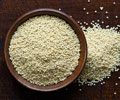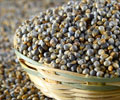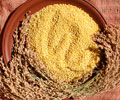Millets versus Wheat and Rice
Millets contain much higher amounts of fiber and essential minerals than wheat, rice and other cereal grains.
Broken wheat, oats, unpolished rice and wheat based breads are much healthier options as compared to semolina (suji, rawa), white rice and white bread. They also contain good quality protein with a high content of essential amino acids.
The following table gives the nutrient composition of millets and cereals, and their daily recommended intake of minerals and fiber:
| Cereals/Millets | Protein (g) | Fat (g) | CHO (g) | Minerals (g) | Calcium (mg) (Daily intake is 400 mg/day) | Iron (mg) (Daily intake is 28 mg/day) | Fiber (g) (Daily intake is 25 mg/day | Energy (K Cal) |
| Whole Wheat flour | 12.1 | 1.7 | 69.4 | 2.7 | 48 | 4.9 | 1.9 | 341 |
| Maida | 11 | 0.9 | 73.9 | 0.6 | 23 | 2.7 | 0.3 | 348 |
| Oatmeal | 13.6 | 7.6 | 62.8 | 1.8 | 50 | 3.8 | 3.5 | 374 |
| Semolina | 10.4 | 0.8 | 75 | - | 16 | 1.6 | 0.2 | 348 |
| Bread (brown) (varies with brands) | 8.8 | 1.4 | 49 | - | 18 | 2.2 | 1.2 | 244 |
| Bread, white | 7.8 | 0.7 | 52 | - | 11 | 1.1 | 0.2 | 245 |
| Wheat germ | 29.2 | 7.4 | 53 | 3.5 | 40 | 6 | 1.4 | 397 |
| Rice bran | 13.5 | 16.2 | 48.4 | 6.6 | 67 | 35 | 4.3 | 393 |
| Rice (raw) | 6.8 | 0.5 | 78.2 | 0.6 | 10 | 0.7 | 0.2 | 345 |
| Rice (parboiled) | 8.5 | 0.6 | 77.4 | 0.9 | 10 | 1 | 0.2 | 349 |
| Bajra (pearl millet) | 11.6 | 5 | 67.5 | 2.3 | 42 | 8 | 1.2 | 361 |
| Jowar (sorghum) | 10.4 | 1.9 | 72.6 | 1.6 | 25 | 4.1 | 1.6 | 349 |
| Ragi (finger millet) | 7.3 | 1.3 | 72 | 2.7 | 344 | 3.9 | 3.6 | 328 |
| Rajgira (Amaranth seeds) | 16.5 | 5.3 | 63 | 1.1 | 223 | 17.4 | 2.7 | 319 |
| Barley | 11.5 | 1.3 | 69.6 | 1.2 | 26 | 1.67 | 3.9 | 361 |
(-) values not cited
1 serving of grain is 30 g (raw)
"The value for each nutrient is for 100 grams of raw grain or millet"
Bran and germ (oat bran, wheat bran, wheat germ, rice bran) are highly nutrient and fiber dense. They are commercially available in supermarkets and should be judiciously added to food preparations.

